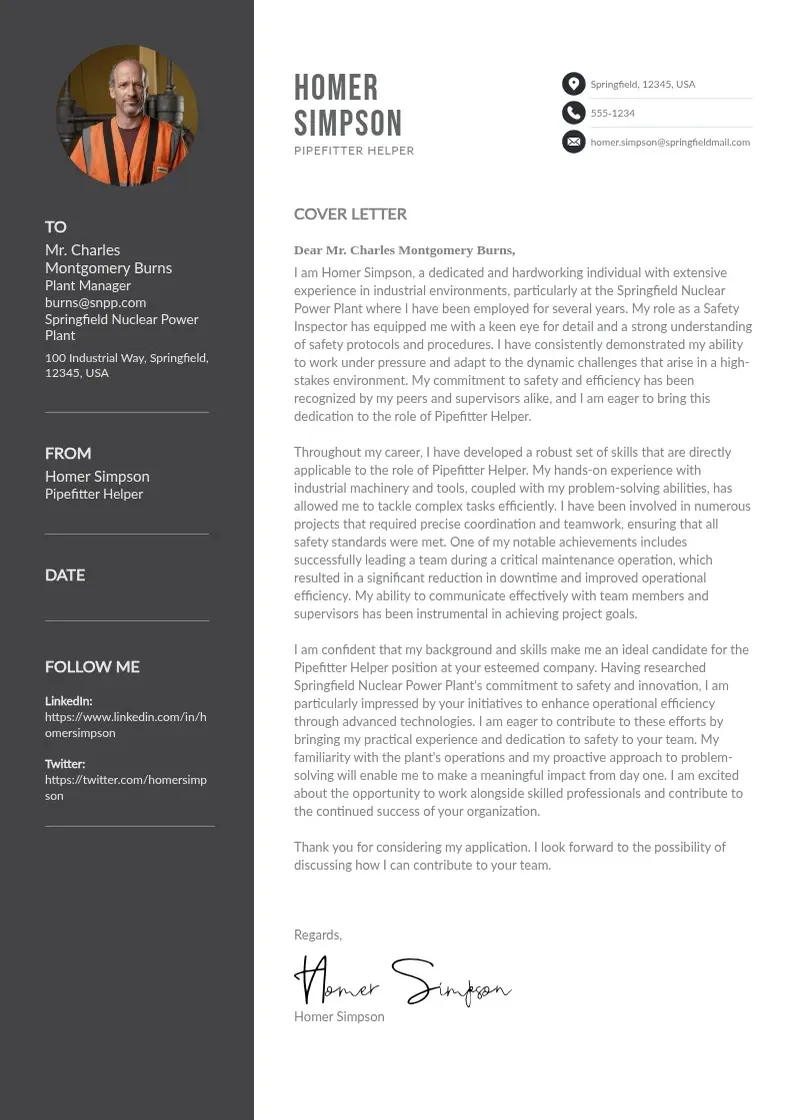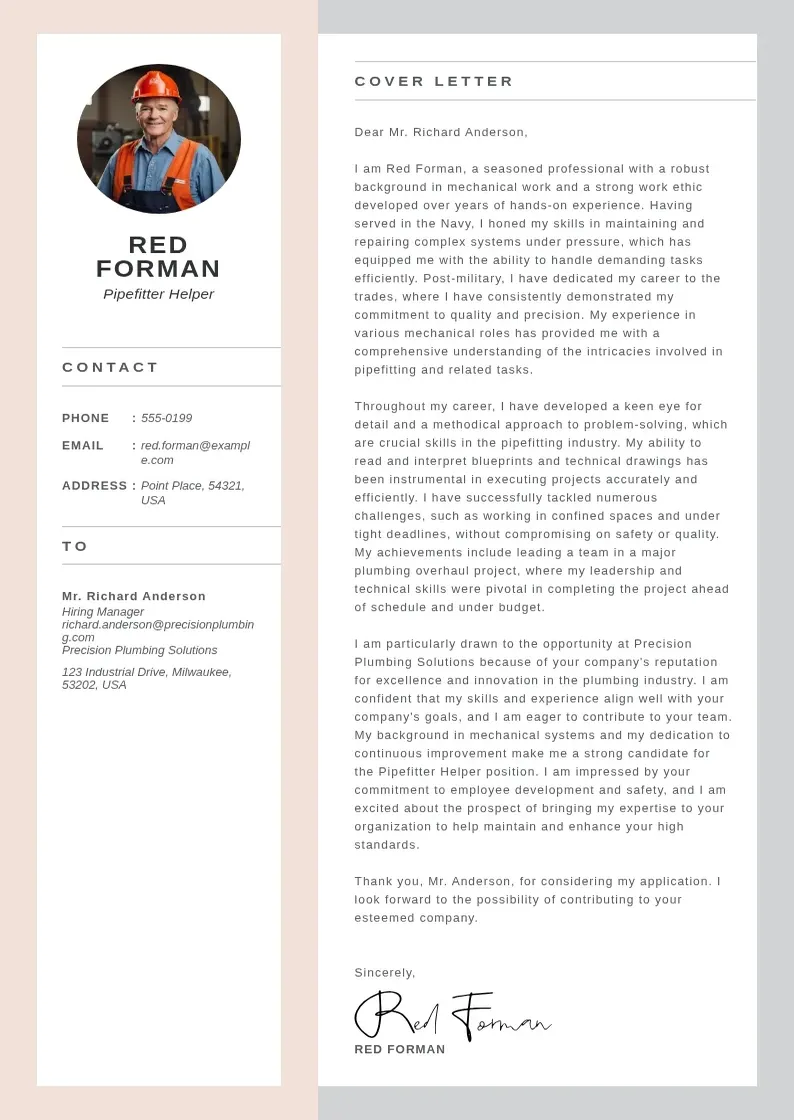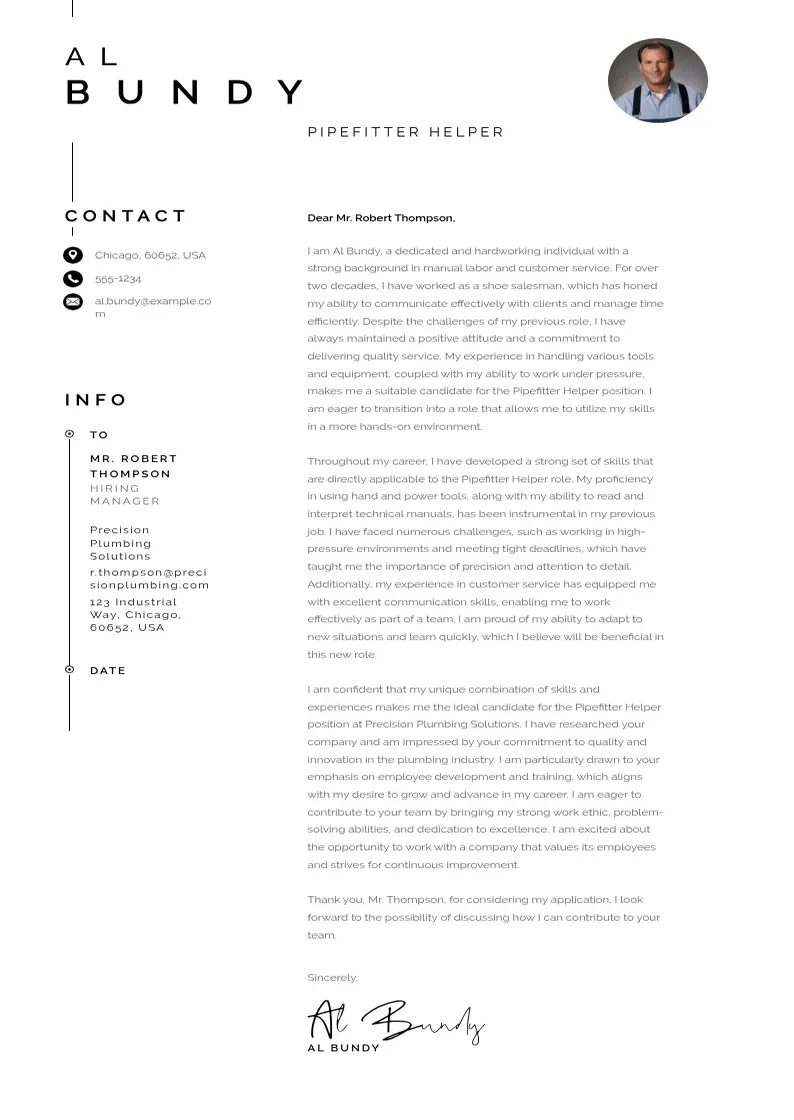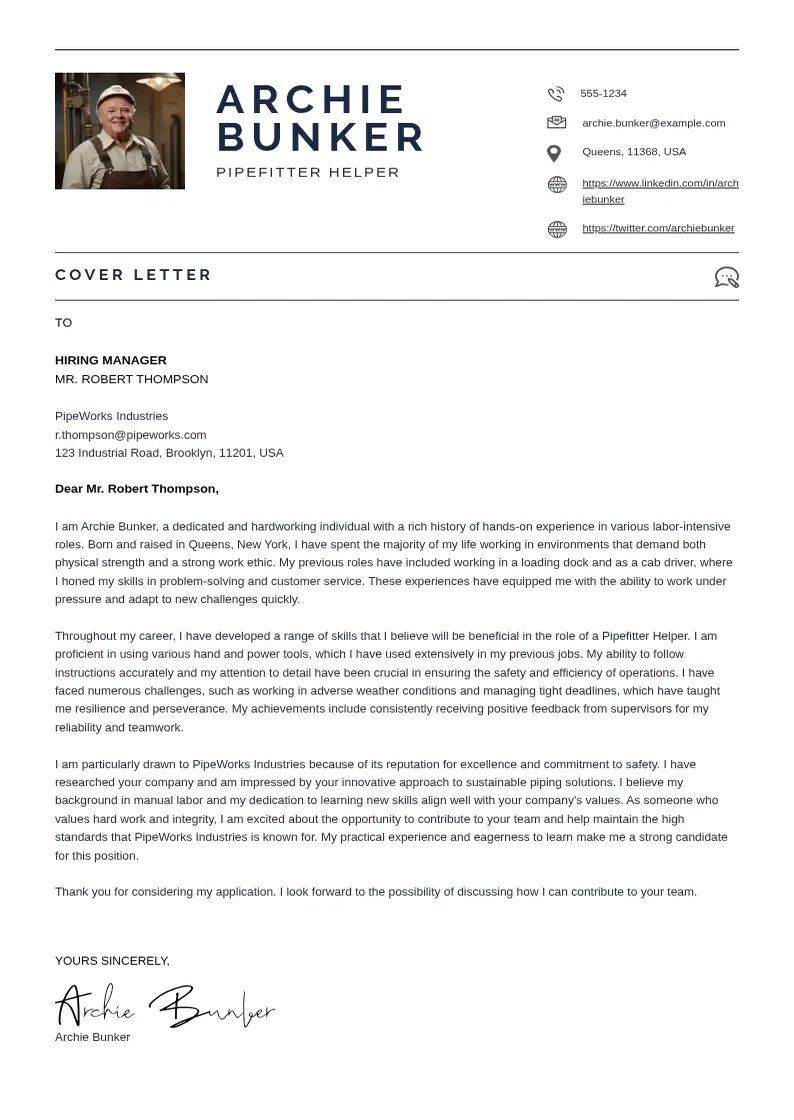
Understanding the Crucial Role of a Well-Structured Cover Letter for a Pipefitter Helper's Job

Embarking on a career path as a Pipefitter Helper presents numerous rewarding challenges and opportunities for growth. One of the first hurdles to clear in this journey is crafting a well-structured cover letter that effectively communicates one’s skills and experiences. The layout of this document plays a crucial role in its clarity, readability, and impact. A well-organized cover letter can significantly increase the chances of catching the hiring manager's attention and making a memorable first impression. Thus, it is essential to devote adequate time and effort in ensuring the cover letter is strategically structured, making it a powerful tool in achieving your career goals.
Contact Information Section in a Pipefitter Helper's Cover Letter
When addressing the hiring manager or employer in your application for a Pipefitter Helper position, the salutation should be professional and respectful. If you know the name of the employer or hiring manager, it is best to address them directly. For example, "Dear Mr. Smith," or "Dear Ms. Johnson," depending on their gender. If you do not know the name of the person you are addressing, it is appropriate to use a general salutation such as "Dear Hiring Manager," or "Dear Pipefitter Helper Selection Committee." It is also important to remember that the salutation should be followed by a colon, not a comma.
- "Dear Mr. Smith:"
- "Dear Ms. Johnson:"
- "Dear Hiring Manager:"
- "Dear Pipefitter Helper Selection Committee:"
- "Dear Sir/Madam:

Crafting an Engaging Opening Paragraph for a Pipefitter Helper's Cover Letter
In the opening paragraph of a cover letter for a Pipefitter Helper position, the applicant should introduce themselves and clearly articulate their interest in the plumbing role. They should express enthusiasm about the opportunity and elaborate on why they are attracted to this position. It's also important to indicate where or how they became aware of the job opening. For instance, if they found the job posting on a specific website or were referred by someone within the company, such details should be highlighted. This not only shows that the applicant is proactive in their job search, but it also provides valuable feedback to the company about where their recruitment efforts are most effective.
Crafting Effective Body Paragraphs in a Pipefitter Helper's Cover Letter
The main body paragraphs in a Pipefitter Helper's cover letter are of critical importance as they provide a platform to showcase your skills, experiences, and relevant qualifications. These paragraphs allow you to align your competencies with the job requirements, thereby convincing the potential employer of your suitability for the role. They also serve as an avenue to relate your past experiences to how you can contribute in the prospective job position. A well-structured main body not only highlights your aptitude and knowledge about the pipefitting industry but also demonstrates your communication abilities and attention to detail, which are essential attributes for any Pipefitter Helper position.
The first paragraph of a cover letter for a Pipefitter Helper is crucial as it sets the tone for the rest of the letter. It should immediately capture the attention of the employer by highlighting the applicant's most important skills and relevant experience. This will show the employer that the applicant is qualified for the job. Additionally, the skills mentioned should be directly related to the job requirements, as this will demonstrate to the employer that the applicant has read and understood the job description and knows what will be expected of them in the role.
The second paragraph of a Pipefitter Helper's cover letter should highlight the individual's accomplishments and contributions in previous roles. By doing so, the applicant can demonstrate their value and competence in the field. This can include mentioning specific projects they have worked on, problems they solved, or skills they acquired.
Furthermore, the applicant should draw a clear connection between these achievements and the potential benefits they can bring to the prospective employer. For instance, if the applicant has a record of completing projects ahead of schedule, they can emphasize how this efficiency could be advantageous to the employer's operations. By clearly articulating their past successes and their potential impact, the applicant can make a compelling case for their candidacy.
The 3rd paragraph of a cover letter for a Pipefitter Helper position should demonstrate understanding and knowledge of the hiring company. This might include awareness of the company's history, its values, its mission, its projects, and its industry reputation. Showing this knowledge illustrates a genuine interest in the company, proving that the applicant didn't send a generic cover letter but took time to research and understand the company.
Moreover, explaining why the company is an ideal fit is also crucial. This can involve aligning the company's values or work with the applicant's own career goals, skills, and experiences. This will show the employer that the applicant isn't just looking for any job, but specifically wants to work in their company. This makes the applicant more appealing, as they are likely to be more committed and motivated if hired.

Concluding Your Pipefitter Helper Cover Letter: Crafting the Perfect Closing Paragraph
A well-crafted closing paragraph in a Pipefitter Helper cover letter can significantly enhance your chances of getting an interview call. This final paragraph serves as your last chance to leave a lasting impression on the hiring manager. It's crucial to express your enthusiasm for the opportunity and your eagerness to discuss your qualifications further in an interview. This shows your interest and proactive approach, which can help you stand out from the crowd. Also, it's essential to provide your contact details to make it easy for the recruiter to get in touch with you. Lastly, expressing your gratitude for their time and consideration not only shows your politeness but also your professionalism. A good closing paragraph, therefore, is a powerful tool that can help you secure the desired job opportunity.
Crafting the Perfect Complimentary Close for a Pipefitter Helper's Cover Letter
In a professional setting, especially when applying for a job such as a Pipefitter Helper, the appropriate complimentary close is crucial in leaving a positive impression. This is the last part of the letter, and it gives you a chance to show respect to the recipient. It also sets the tone for your potential future interaction with the employer. The most commonly used professional closing phrases include:
- "Sincerely,"
- "Best Regards,"
- "Kind Regards,"
- "Thank you for your consideration,"
- "Looking forward to your positive response,"
- "Respectfully,"
Incorporating Your Signature in a Pipefitter Helper's Cover Letter
While both digital and handwritten signatures can be used in a Pipefitter Helper cover letter, a digital signature might be better suited for this purpose. With most job applications now being submitted online, a digital signature can provide a personal touch while maintaining the convenience and professionalism of an online submission. On the other hand, a handwritten signature might be more appropriate if the cover letter is being sent by mail or handed in person. However, the quality of a scanned handwritten signature can deteriorate, making it look unprofessional. Therefore, a digital signature is usually the preferred choice for online applications, but the key is to ensure that it is recognizable and professional.

Handy Tips for Crafting a Compelling Pipefitter Helper Cover Letter
Writing a cover letter for a Pipefitter Helper position may seem like a daunting task, but with the right approach, it can be straightforward and effective. Here are some additional tips and good practices that can help you craft an impactful cover letter.
- Understand the Job Requirements: Before writing your cover letter, thoroughly read the job description to understand what the employer is looking for in a candidate. Make sure you understand the tasks involved in the role and the skills required.
- Highlight Relevant Skills and Experience: Identify the skills and experiences that are most relevant to the job you are applying for. These could be practical skills, like knowledge of pipefitting techniques or the ability to use specific tools, or soft skills, like teamwork and problem-solving. Ensure these are clearly highlighted in your cover letter.
- Be Specific and Quantifiable: Rather than just stating that you have certain skills or experience, provide specific examples of when you have demonstrated these. If possible, include measurable results. For example, instead of saying "I have experience in pipefitting", you could say "I have two years of experience as a Pipefitter Helper, during which I assisted in the installation and maintenance of over 100 piping systems".
- Show Enthusiasm for the Role: Employers want to hire people who are genuinely interested in the job and the company. Show your enthusiasm by discussing why you are interested in the role and what you hope to achieve in it.
- Be Professional: Remember that a cover letter is a professional document. Use formal language, avoid slang or colloquialisms, and ensure your letter is well-structured and easy to read.
- Proofread for Errors: One of the most crucial steps in writing a cover letter is proofreading. Errors in your cover letter can give the impression that you lack attention to detail or are not serious about your application. Always proofread your letter several times, and consider asking someone else to check it as well.
- Follow the Correct Format: A cover letter should be neatly formatted and easy to read. Use a standard font and size, and keep the length to one page. Your letter should include your contact information, the date, the employer's contact information, a greeting, an introduction, a body, a conclusion, and a signature.
- Tailor Each Cover Letter: Avoid using the same cover letter for every job application. Tailor each letter to the specific job and company you are applying to. This shows the employer that you have taken the time to understand their requirements and are genuinely interested in the role.
- Use Bullet Points: If you have a lot of information to convey, consider using bullet points. This can make your cover letter easier to read and allows you to highlight your most relevant skills and experiences effectively.
- End on a Positive Note: Close your cover letter on a positive and forward-looking note. Express your interest in the opportunity to discuss your qualifications further and thank the employer for considering your application.
By following these tips and good practices, you can craft a cover letter that effectively highlights your skills and experiences, and increases your chances of landing a Pipefitter Helper position.

Final Thoughts on Crafting the Perfect Pipefitter Helper Cover Letter
In conclusion, crafting a compelling cover letter for a Pipefitter Helper position is a crucial step in the job application process. It should be succinct, personalized, and highlight the applicant's essential skills such as technical aptitude, physical strength, teamwork, attention to safety, and their ability to follow instructions. The cover letter should also reflect the applicant’s understanding of the job role and their eagerness to contribute positively to the company.
A powerful cover letter can make a significant difference in securing an interview and ultimately landing the job. It serves as the first impression tool and a platform to showcase your unique experiences, talents, and potential. Remember, the goal is not just to list what's on your resume but to provide a personal touch, explaining why you're the perfect fit for the position.
Job seekers are encouraged to adapt the provided template to fit their circumstances and highlight their unique experiences. Every job application is a chance to demonstrate your potential and a well-crafted cover letter can be the key to unlock that opportunity. So, pour your passion, dedication, and skills into your cover letter and take the first step towards your dream job.































